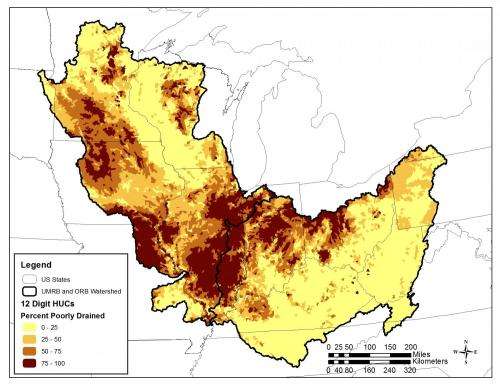Farmers can better prevent nutrient runoff based on land characteristics

Farmers on a quest to keep more fertilizer on their fields—and out of Iowa's waterways—may have an easier time finding a solution, thanks to new research from the University of Iowa.
Researchers with the Iowa Geological Survey, housed at the University of Iowa College of Engineering's IIHR-Hydroscience & Engineering, have created a comprehensive nutrient runoff mitigation guide for farmland in both the Ohio and Upper Mississippi River Basins.
The goal of the guide, contained in an article published in the journal Environmental Management, is to reduce the overabundance of choice farmers can face in approaching nitrate and phosphate nutrient reduction. Farmers can identify their soil type, land slope, crops grown, and nutrients used, and the researchers' guide can deliver them a best-practice solution for optimal run-off mitigation.
"Narrowing the scope of choice can sometimes be the best strategy for making decisions," the researchers say.
Keith Schilling, first author on the study, and his colleagues at the Iowa Department of Natural Resources and the Environmental Defense Fund, realized that the differences in farmland meant that a one-size-fits-all approach to nutrient reduction was not the most effective method.
They developed a geographic information system (GIS) framework to study more than 11,000 watersheds around the Ohio and Upper Mississippi Rivers, classifying them based on a number of factors, including: how well or how poorly the soil drained, how steep the slope of the land was, and how much cropland existed in a given watershed.
"The classifications really drive how water is moving through the system. So, if you have high slopes, and we say slopes over five percent slope, and you have soils that are clay-or-silt- dominated, with low permeability, you're going to get a lot of run-off generated," says Schilling, first author on the study.
For the type of farmland Schilling describes—a high-sloped land with a lot of runoff—the research recommends that farmers use some combination of grass waterways, contour filter strips, terraces, ponds, riparian buffers, and cover crops. This is in contrast to the methods recommended for low-sloped, well-drained land. For that type of situation, Schilling's research suggests farmers pay increased attention to in-field source controls, and use methods such as two-stage ditches, floodplain reconnection, and off-channel wetlands.
The researchers envision their guide as equally useful for conservation professionals and watershed managers, who can often be faced with an "overwhelming array of choices," according to the article. While it is common to think that more choices can be better, the researchers say more choice can often lead to indecisiveness and inaction. With more guidance, the researchers hope that already-limited conservation resources will be directed in the most effective ways. Much of that focus remains on Iowa, Schilling says.
"We do categorize the farmlands in Tennessee and West Virginia, because they contribute to the Ohio and Mississippi Rivers. But there isn't much land there to begin with that's in agriculture. You go to north central Iowa, 80 to 90 percent of the land is in agriculture," Schilling says.
While Schilling believes methods that can increase water run-off, such as tile farming, are necessary parts of life in the Hawkeye State, he is optimistic that guiding people toward best practice solutions will only increase the number of farmers participating in the Iowa Nutrient Reduction Strategy, introduced by Gov. Terry Branstad and Secretary of Agriculture Bill Northey in May 2013. The strategy was formulated by the state after two years of research and in response to the 2008 Gulf Hypoxia Action Plan, a federal call for the 12 states surrounding the Mississippi River to reduce their nutrient runoff load flowing into the Gulf of Mexico.
The state created the plan as a "dynamic document that will evolve over time," and Schilling says this research helps the plan take a step in the right direction.
Journal information: Environmental Management
Provided by University of Iowa


















